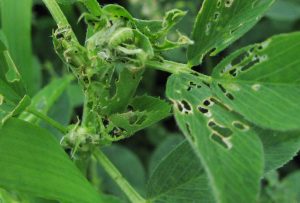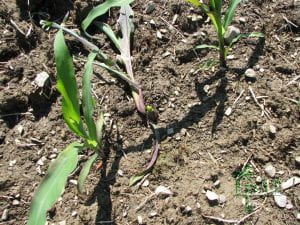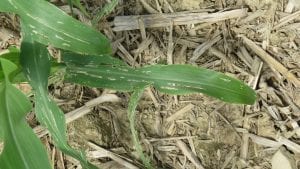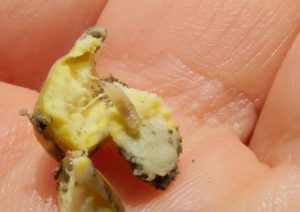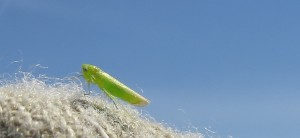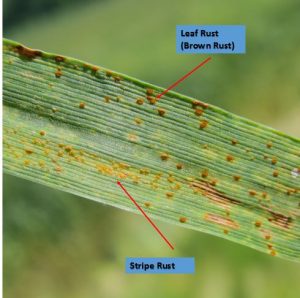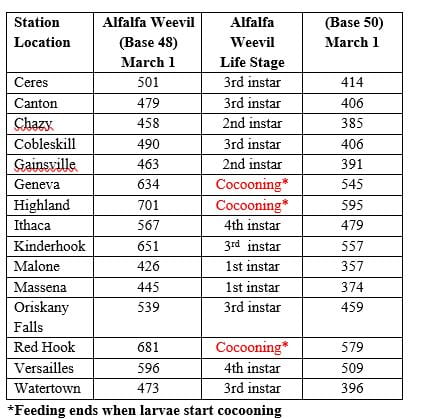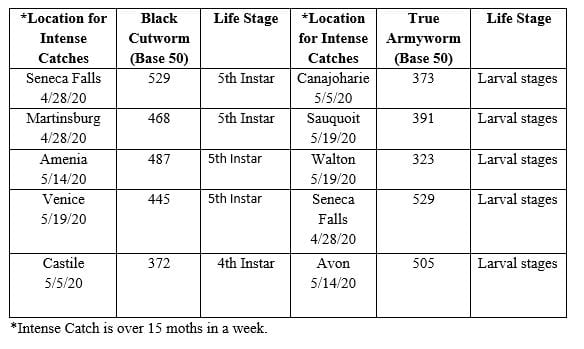NYS IPM Weekly Field Crops Pest Report
Volume 19, Number 6
View from the Field
Alfalfa Weevil
Jodi Putman (CCE Northeast Dairy, Livestock and Field Crops Team) reports high levels of alfalfa weevil in alfalfa regrowth. Other areas of the state are starting to see alfalfa weevil at moderate to low levels in alfalfa regrowth. The action threshold for alfalfa weevil in alfalfa regrowth is 50 percent of the new growth is damaged, with larvae less than 3/8 inch long and no cocoons present, a chemical control may be warranted.
Small Grains Diseases
Gary Bergstrom (Cornell University) Jaime Cummings (NYS IPM), Mike Stanyard (CCE Northeast Dairy, Livestock and Field Crops Team) and Christian Malsatzki (CCE Ulster County) report low levels of several diseases in small grains. These include powdery mildew, barley yellow dwarf virus, scald, spot blotch, stripe rust, leaf rust, septoria leaf blotch, Stagonospora leaf blotch and Cephalosporium stripe. See the article below on stripe rust.
Black Cutworm and True Armyworm
Mike Stanyard (CCE Northeast Dairy, Livestock and Field Crops Team) reports moderate damage by black cutworm in corn. He also found moderate damage by true armyworm in triticale.
Slugs
Aaron Gabriel (CCE Capital District), Jaime Cummings, (NYS IPM) and Ken Wise (NYS IPM) report finding low to moderate levels of slug damage in field corn.
Seed Corn Maggot
Jaime Cummings (NYS IPM) reports low levels of seed corn maggot in field corn.
Potato leafhopper
Potato leafhopper is being found at low levels in central and eastern New York
Stripe rust of wheat management update
(Gary C. Bergstrom, Plant Pathology and Plant Microbe Biology Section, School of Integrative Plant Science, Cornell University)
Stripe rust has now been confirmed in portions of single wheat fields in each of Seneca and Wayne Counties, but to date is not widespread or severe in New York. Leaf rust has been observed at low severity only in an irrigated research trial in Tompkins Co. If foliar rusts, but especially stripe rust, become established in a field at or before flag leaf emergence stage, significant yield losses can occur in susceptible varieties. Planting varieties with resistance to prevailing races of specific rust diseases remains the first line of defense against rusts. Many foliar fungicides applied before flag leaf emergence are effective in management of stripe rust as well as leaf rust (see Table 5.7.1 in Cornell Guide for Integrated Management of Field Crops). These include products containing QoI fungicides (FRAC Group 11), DMI (FRAC Group 3) fungicides and mixed mode of action fungicides. Once flag leaves have appeared, products containing QoI fungicides should no longer be applied, due to their tendency to result in an increase in mycotoxin contamination in grain. Both leaf rust and occasionally stripe rust tend to show up after head emergence in New York and that appears to be the case in 2020. Application of Caramba, Prosaro, or Miravis Ace at wheat flowering (anthesis) provides excellent control of stripe or leaf rust that may otherwise develop on flag leaves during early grain filling stages. In replicated plots in 2016, we saw significant reduction in stripe rust (from 5% of flag leaf area rusted to not detected) with application of Caramba or Prosaro at anthesis. Fungicide emergence should cease by the end of anthesis to avoid illegal residues based on days to harvest restrictions.
Black Cutworm Captures
True Armyworm Captures
Alfalfa Weevil, Seed Corn Maggot and Base 50 F Degree Days
June 14, 2020
Stage
Alfalfa Degree Days Life Stages
(Base Temperature 48F)
Egg Hatch 280
Instar 1 315
Instar 2 395
Instar 3 470
Instar 4 550
Cocooning 600
Pupa 725
Adult Emergence 815
Black Cutworm and True Armyworm Degree Days
June 14, 2020
Black Cutworm Degree Days (Base 500 F) Lifecycle Growth Stages
Degree Days Stage Feeding Activity
0 Moth Capture Egg Laying
90 Eggs Hatch
91-311 1st to 3rd Instar Leaf Feeding
312-364 4th Instar Cutting Begins
365-430 5th Instar Cutting Begins
431-640 6th Instar Cutting Slows
641-989 Pupa No feeding
Source: University of Minnesota Insect Pest of Corn-Stand Reducers Black Cutworm
True Armyworm Degree Days (Base 500 F) Lifecycle Growth Stages
Degree Days Stage Feeding Activity
0 Moth Capture Egg Laying
113 Eggs Hatch
612 Larval stages Leaf Feeding
909 Pupa No feeding
Clipboard Checklist
Keith Waldron, NYS IPM
General
*Walk fields to check general field condition, weed issues, areas of soil erosion
*Watch for early season weeds: winter annuals, chickweed, henbit, field penny cress, shepherd’s purse, giant and common ragweed, purple deadnettle, lambsquarters, redroot pigweed, velvet leaf, Pennsylvania smartweed, common sunflower, quackgrass, foxtail
Alfalfa:
*Evaluate established legume stands for approximate days til harvest
*Monitor regrowth for alfalfa weevil, potato leafhopper
*Monitor new seedings for Pythium blight and Phytopthora Root Rot.
Small Grains:
*Monitor winter grain fields for growth stage, disease issues, cereal leaf beetle
*Check stands for diseases, cereal leaf beetle, weed escapes
*Monitor wheat for potential risk of fungal disease issues – consult Fusarium Head Blight
prediction model
Corn:
*Conduct plant population assessments, early season corn pests including seed corn maggot, white grub, wireworm, black cutworm, armyworm, slugs, diseases, weed issues, vertebrate damage
Soybeans:
*Post emergence weed evaluation, timely cultivation and/or weed management
*Conduct plant population assessments, early season corn pests including seed corn maggot, slugs, soybean aphid, diseases, weed issues, vertebrate damage
Pastures:
*Check and mend fences as needed.
*Check crop growth
*Invasive species, plants harmful to livestock
*Review/Plan rotation system
Equipment:
*Remove / clean soil and crop debris from equipment
*Arrange for custom weed control or check your own application or cultivator equipment for repairs.
*Carry appropriate / necessary NYS DEC and EPA required documents: (pesticide applicators license, pesticide labels, MSDS sheets, etc.) with application equipment
*Calibrate:
- planting equipment – maintain records on planting rate per field
- manure spreaders – maintain records on amount spread per field
- pesticide application equipment – Check nozzles, pumps, etc., recalibrate pesticide application equipment before use. Maintain pesticide use records
Storage:
* Check stored grain bins for temperature, moisture and signs of mold and insects. Aerate, core, transfer grain or treat as necessary
*Check forage allocation and anticipate feed program adjustments as forages from previous year are used up
*Plan where forages should be stored for optimum allocation next feeding season
*Mow around storage bins and facility to minimize pest hiding places
Dairy Cattle Barn Fly Management:
*Monitor animals and barn area for house fly, stable fly and other pest management needs including presence of rodents and birds.
*Check facilities for favorable fly breeding conditions: (organic matter + moisture): leaks in watering systems, roof gutters for leaks and potential overspill, drainage,
*Sanitation, sanitation, sanitation – clean animal resting areas, feed troughs, minimize source of moist organic matter i.e. fly breeding areas in barn and in adjacent animal loafing yard
* Continue fly monitoring: install “3X5″ index card fly speck monitoring cards throughout barn
*Use, replenish, replace fly management materials: sticky fly tapes/ribbons, insecticide baits, natural enemies (parasitoids), fly population monitoring (3 x 5) spot cards
*Consider purchase and release of Muscidifurax raptor and/or M. raptorellus natural enemies of house and stable fly pupae.
Dairy Cattle on Pasture:
*Monitor animals for presence of face flies, horn flies and stable flies. Action guidelines: face flies (average 10 per animal face), horn flies (average 50 / dairy per animal side, 200 / beef cattle per animal side), stable flies average 10 per animal (all four legs)
*Check feed bunk / water source locations for signs of stable fly breeding (moist undisturbed organic matter – spilled feed, round bales, etc.), minimize source of moist organic matter i.e. fly breeding areas in barn and in adjacent animal exercise yard.
*Check pasture for forage quality / quantity, rotate as appropriate
*Check pasture for vegetation poisonous to livestock
*Consider use of pasture fly traps to help reduce deer, horse and stable fly populations


